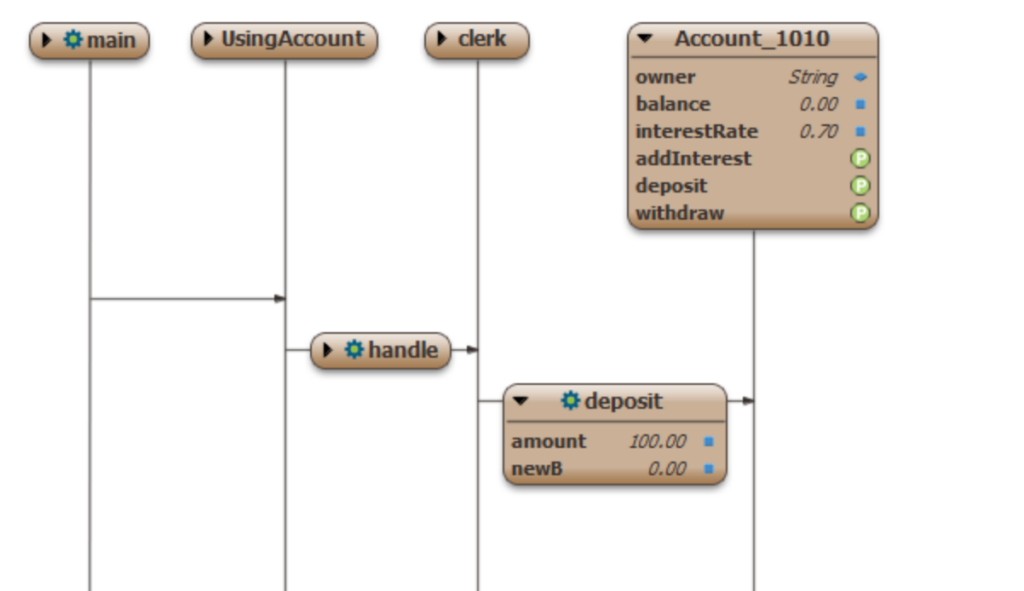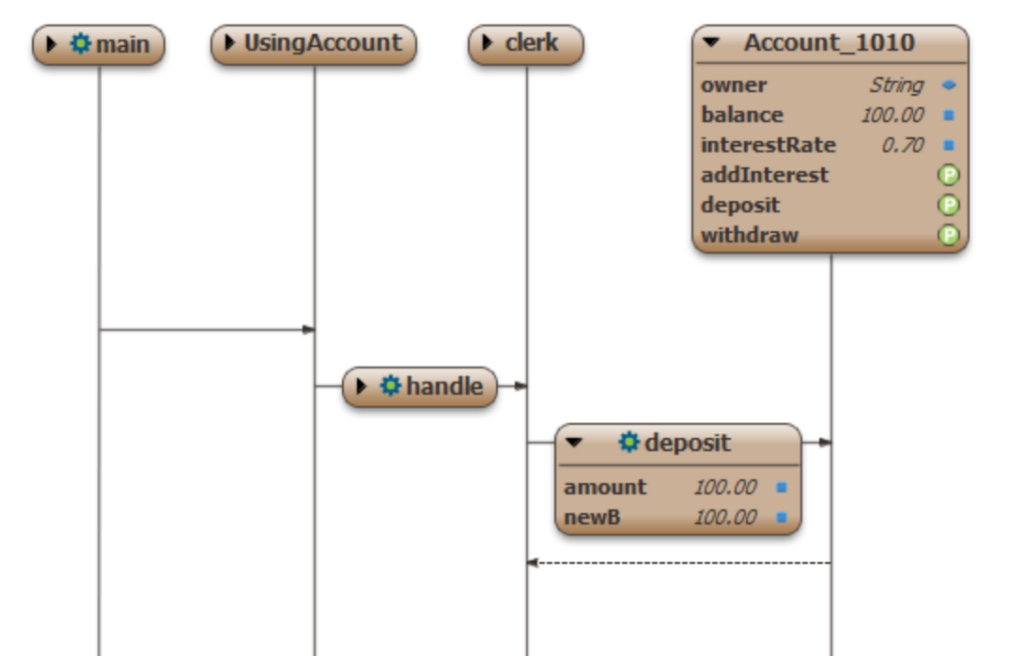Until now, we have been using diagrams to illustrate objects and classes. +++ no classes so far!
The diagrams for objects illustrate snapshots of the state of an object during program execution and thus the dynamic structure of the program – these diagrams called object-diagrams.
The diagrams for illustrating classes is a way to illustrate the program text and thus the static structure of a program – these diagrams are called class-diagrams.
In this section, we introduce diagrams for showing snapshots that further illustrate the dynamic structure including the state of objects, method invocations and method activations during program execution. These diagrams include object diagrams and are called Object-Sequence Diagrams (OSD). In addition to object diagrams, they illustrate method invocations.
The state of a program execution at a given point in time is:
- The set of objects (including method objects) in the program execution.
- The datums currently hold by objects in the program execution
- As mentioned a datum may be a reference to an object or a value.
- The point of execution of each object.
In general, a snapshot of a program execution is part of the state of the program execution at particular points in time. The term snapshot is used as an analogy to that a in photography.
We use the object usingAccount from the previous section. The diagram below shows a snapshot at the following point of the execution usingAccount:
- The system object
mainhas invoked theusingAccountobject. usingAccounthas invoked thehandlemethod ofclerk.- The
clerkhas invokeddepositonAccount_1010.
As said, main is an object that is generated by the computer-system with the purpose of initiating execution of usingAccount.
Skal vi gentage usingAccounts her?

The diagrams four columns representing the four objects, main, usingAccount, clerk and account_1010. The vertical lines from these objects are called lifelines and represents time as seen by the object.
A method invocation is shown as an arrow from the lifeline of the caller object to the lifeline of the receiver. The arrows are labeled by the name of the method being invoked.
The arrow from main to UsingAccount has no method label. Such an arrow represents the situation where the caller (in this case main) is generating the object (in this case UsingAccount).
The arrow from main to usingAccount is above the arrow from clerk.handle, which is above the arrow for account.deposit(100), illustrating the order in time of these method invocations.
A stack is a data-structure that may contain a collection of objects where you may insert and remove objects. Insertion is called push and removal is called pop. Elements are pushed on top of the stack which means that when you pop an element, you get the one that has been pushes latests. We further explain stack sin section X
The horizontal lines showing the active method invocations are often referred to as the invocation stack, execution stack or just stack. In the figure above, deposit is on top of the stack and main is the bottom of the stack.
Det viste sig at forklaringen af stack er mere omfattende end jeg lige troede. Vi skal forklare push/pop, etc. Og lige nu er ikke forklaret hvorfor execution stack er en stack. Så måske vi skal forklare stack senere? Og skal vi indføre stack i kapitlet om collecions?
The next diagram shows a snapshots where invocation of deposit returns to the caller (clerk). The dotted line indicates a return of a method.

As said above, the lifelines and arrows showing method invocations represents how actions are ordered in time. The ordering of the objects in the columns does not matter, but usually a diagram may be more readable if the ordering in time flows from left to right to the extend that this is possible.
It is possible to inspect the state of the objects and method activations as illustrated by the next diagram:

In this snapshot, the Account_1010 object and the deposit invocation have been expanded, and we may thus see the datums of these object at this point of execution.
The amount parameter of deposit has the value 100.00; the return value newB has the value 0.00.
For Account_1010, the datum of owner is a String; the values of balance is 0.00 and the interestRate is 0.70.
The next snapshot shows the state at the return of deposit. Here we can see that the balance of Account_1010 has been updated to 100.00 and that newB of deposit also has the value 100.00.

The next snapshot shows the state at the return of addInterest and the balance is now 327.27.

The final snapshot shows the state at the return of the withdraw made by the clerk before invoking console.print. As can be seen, the balance is 216.27.

The above snapshots just show the active method invocations. Sometimes one may want to show (a subset of ) previous method invocations. The next diagram shows the history of all method invocations performed by the clerk on account_1010.

In later examples, we should also show that you can expand references to other objects.
The OSD’s being used in this book are generated by a tool called qenv that may execute qBeta programs.
